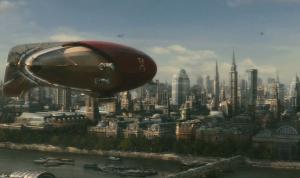Post
Mirror, Mirror
3 May 2013
 New Line Cinema
New Line CinemaThe idea of parallel worlds is widely used in science fiction. Most often this alternate world is either populated by our evil doppelgangers, or the alternate universe is just slightly different from ours, such as having zeppelins in a modern city. Then there is the “alternate history” fiction, where their world is identical except for a key moment in history. Lincoln survived, Harold Godwinson won the battle of Hastings, etc.
Perhaps the earliest example of alternate universes in physics comes from the 1957 paper1 by Hugh Everett titled “Relative State Formulation of Quantum Mechanics.” Everett’s paper was an attempt to eliminate the need for an “observer” in quantum mechanics.
Although it is a well tested theory, quantum mechanics can be hard to wrap your head around. As the theory was developed, a standard interpretation was adopted known as the Copenhagen interpretation. The basic idea of this interpretation is that a quantum system is described by a wavefunction, which then collapses into a particular state when “observed.” For example, suppose had a quantum “coin.” Before we measure the coin, we only know the result will either be heads or tails. We have no way of knowing what the result will be, only that we have a 50/50 chance of either outcome. In the Copenhagen interpretation the coin is described by a probability wavefunction. Once we measure the coin (and, say, observe that it is “heads”) then the coin is in a definite state of “heads.” The wavefunction is said to have collapsed into a single state.
This seems rather simple, but the “observer” is not clearly defined. In early quantum theory it was simply assumed to be some larger system. But the world is not divided between “quantum” and “classical” things. If our coin is in a quantum state, then we as the observer should also be in a quantum state. We can’t simply declare a classical observer. So the Copenhagen interpretation isn’t really an accurate way to describe quantum mechanics, though it is still the most commonly taught approach.
Everett’s approach was to remove the “classical” observer. Instead, he proposed that observation is an interaction that decouples the outcome states. If we go back to the coin idea, initially the coin is described by a wavefunction where both heads and tails are possible. The observer is also described by a wavefunction in which it can observe either heads or tails as the outcome. When the observer and coin interact, their wavefunctions don’t collapse, but instead the quantum states separate into one quantum state where the coin is “heads” and the observer measures “heads,” and another quantum state where the result is “tails.”
This eliminates the need for a “classical” observer, but it means the system has split into two systems. On the cosmic scale it means the universe has split into one where the result is heads and one where the result is tails. Each measurement separates (decoheres) the quantum state of the universe into two states. Presumably this would happen with every possible outcome. So there is a universe where you asked that cute brunette out to dinner, and one where you didn’t. In the universe where you asked them out, there is a version where they said yes and another where they said no. So the universe splits at every possible outcome, and (in one interpretation) all outcomes are real. All of these parallel universes splitting and splitting at every quantum choice.
Of course in Everett’s formulation, once quantum states split they no longer influence each other. They have a common past, but no future interactions. So there is no way to travel to or communicate with the version of you that is a billionaire and ask for a loan. This also means that Everett’s many-worlds approach is completely untestable. It may have some philosophical appeal, and may even be real, but it is not a testable hypothesis.
Another appearance of parallel universes comes by way of string theory, and its generalization M-theory. In M-theory, there are 11 dimensions, and our 4-dimensional universe is a membrane (or brane) within this higher-dimensional space. Very roughly, you can visualize our universe as a sheet of paper in a large room. But this means there could be other universes in this 11-dimensional “multiverse.” These could be parallel to our universe. In M-theory, they might interact with our universe gravitationally. There are some models that propose this as a solution to dark matter, for example. But of course all of this is very speculative, and at present there is no experimental evidence for string theory or M-theory. And these other universes would not necessarily be parallels of our universe.
So it seems that Everett’s many-worlds hypothesis is the closest physics comes to a parallel universe in the way often presented in science fiction. Whether or not these parallel universes are real, we have no way to reach them.
For us, choices have consequences, and we always have to face ourselves when we look in the mirror.
Tomorrow: Aliens! As we learn more of the universe it seems increasingly likely that there is life on other worlds. But if that’s the case, where are all the intelligent aliens?
Everett III, Hugh. “‘Relative state’ formulation of quantum mechanics.” Reviews of modern physics 29.3 (1957): 454. ↩︎